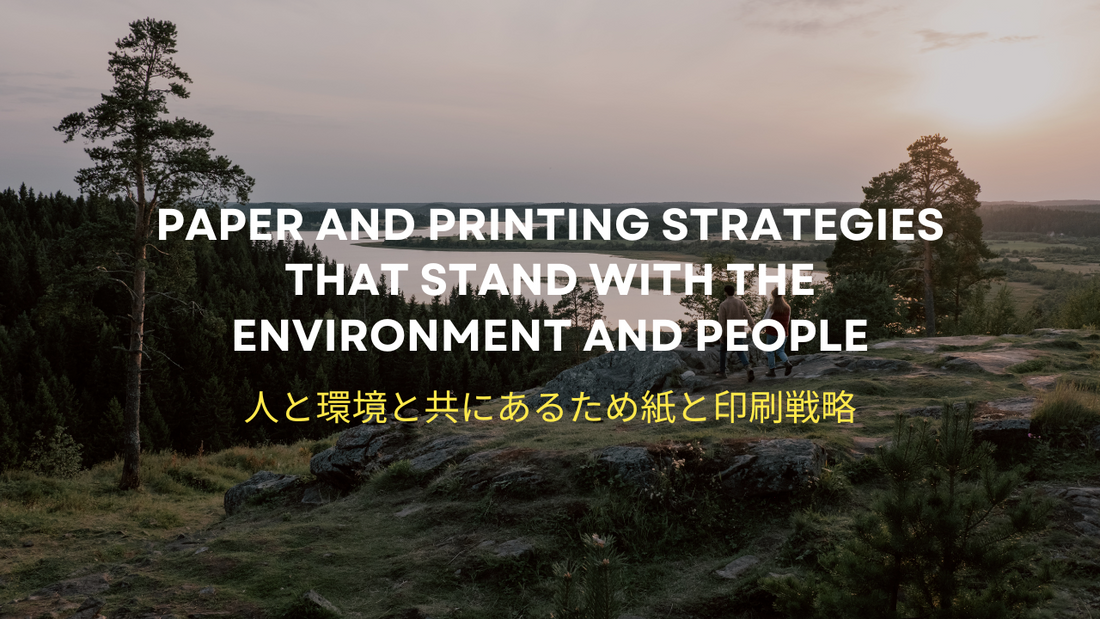Forests purify the air, water, and protect wildlife. Despite being an important resource for its many functions, forests continue to decline today.
As part of our commitment to resource conservation for a future where no one is left behind, we at SOLIT have implemented a program to address the impact of paper resources used in SOLIT's business activities with Shinwa Printing Company, a printing and paper expert that also proposes not to print. Shinwa Printing took the lead in designing and implementing the program.
Paper printing situation, environmental impact
When considering resource use and emissions in paper printing, consideration must be given to the various processes of printing paper, ink, transportation, and disposal. For example, there are two main printing methods: on-demand printing and offset printing. On-demand printing has a lower environmental impact because it prints only the quantity needed, thus reducing inventory and minimizing paper and ink waste.
On the other hand, offset printing, which is said to be suited for high-volume printing, uses relatively large amounts of ink and solvents and is efficient for high-volume printing, but for small-lot printing, there is a possibility of excess printed material, resulting in paper and ink waste. In addition, CO2 emissions from plate making and printing processes tend to be relatively high.
Results of SOLIT Printing and Paper Use
In this initiative, we shared all the data on printed materials in SOLIT's business activities in 2023 with Shinwa Printing, and used a tool called Paper Calculator to calculate the data.
This method is also used by companies such as Patagonia and allows visualization of environmental impacts related to life cycle stages from raw material extraction and processing to waste disposal. However, GHG (greenhouse gas emissions) data is not calculated using the Paper Calculator, but based on a separate document, "Concept of Calculating Supply Chain Emissions," published by the Ministry of the Environment.

Emissions from paper, printing, transportation, delivery, and paper waste are all taken into account in the calculation. Emissions intensity is calculated based on the emissions intensity database used to calculate greenhouse gas emissions from organizations throughout the supply chain.
(1) Examples of attributes of SOLIT printed materials
- Contracts, certificates, delivery slips, and other clerical documents
- Product brochures and instruction manuals
- Postcards and message cards for purchasers
- Flyers for advertisements
- Panels for display, posters for event information
- POP cards for products
- Stickers for packaging
- Business cards
2) Environmental impact of SOLIT's printed materials in 2023.

- Mature trees 0.9
- Total energy 1.2 million
(Energy equivalent to 1.4 refrigerators operating for one year) - GHG 316kg
- Amount of water used 4163L
- Total emissions 25kg
According to Shinwa Printing, who was with us this time, we has a relatively low environmental impact compared to typical apparel companies, small businesses, and start-ups, and by implementing its current initiatives, it has significantly reduced its environmental impact in all categories. In particular, this is due to the fact that SOLIT constantly incorporates environmentally friendly decisions into its daily operations,
- When printing becomes necessary, the number of pages and the binding method are considered from an environmental standpoint, rather than design first, before starting the design process.
- The paper is originally made from recycled paper, bagasse, etc., and uses less forest resources.
- The printing method is on-demand printing, which does not require more paper than necessary.
- The number of documents being printed is limited to what is needed.
- Digital signatures and other contract documents are completed using digital data.
This is particularly true of the minimal printing of flyers and brochures, and keeping delivery notes to the minimum necessary detail.
(3) Breakdown of SOLIT's CO2 emissions in printed materials
In addition, at present, the breakdown of SOLIT's CO2 emissions (%) is as follows.

Paper is 34%, printing is 55%, shipping is 11%, and disposal is 0%.Of these, SOLIT has control over paper and shipping. We will rethink our policies regarding these areas and take the following actions.
Future Policies
Future initiatives in SOLIT include,
1.Reduce the amount of wood used(Reduce unnecessary printing and increase use of recycled paper where necessary)
2.Reduce weight used(Use lighter paper, smaller formats, fewer pages, and bindings that use less paper)
3.Continue on-demand printing
4.Reduce travel distance
5.Use locally produced and locally consumed printing
6.Refrain from producing odd sizes*.
As an example, if paper is one level thinner, using recycled paper with a 60% recycled content ratio as much as possible, and printed by a suburban printing company, it is possible to reduce the amount of trees used by about 60% and CO2 emissions by 10%.* Regarding "5. Refrain from creating odd sizes," so-called standard sizes, such as A4 and A5, are designed so that there is no waste when printing. However, when printing in non-standard sizes and shapes, a slight difference in size may result in doubling the number of sheets of paper needed. Therefore, printing in standard sizes as much as possible will minimize the use of paper resources.
For more information on SOLIT's policy regarding future initiatives, please click here.
In the end.
Not limited to paper printing, by collecting data, it is possible to visualize how much resources are being consumed, the amount of waste, CO2 emissions, etc., and link this to next actions. This program helped us understand once again the importance of visualizing our own efforts through data in order to leave a positive impact on the environment and society, and the importance of continuing to analyze and improve our actions based on this data.


